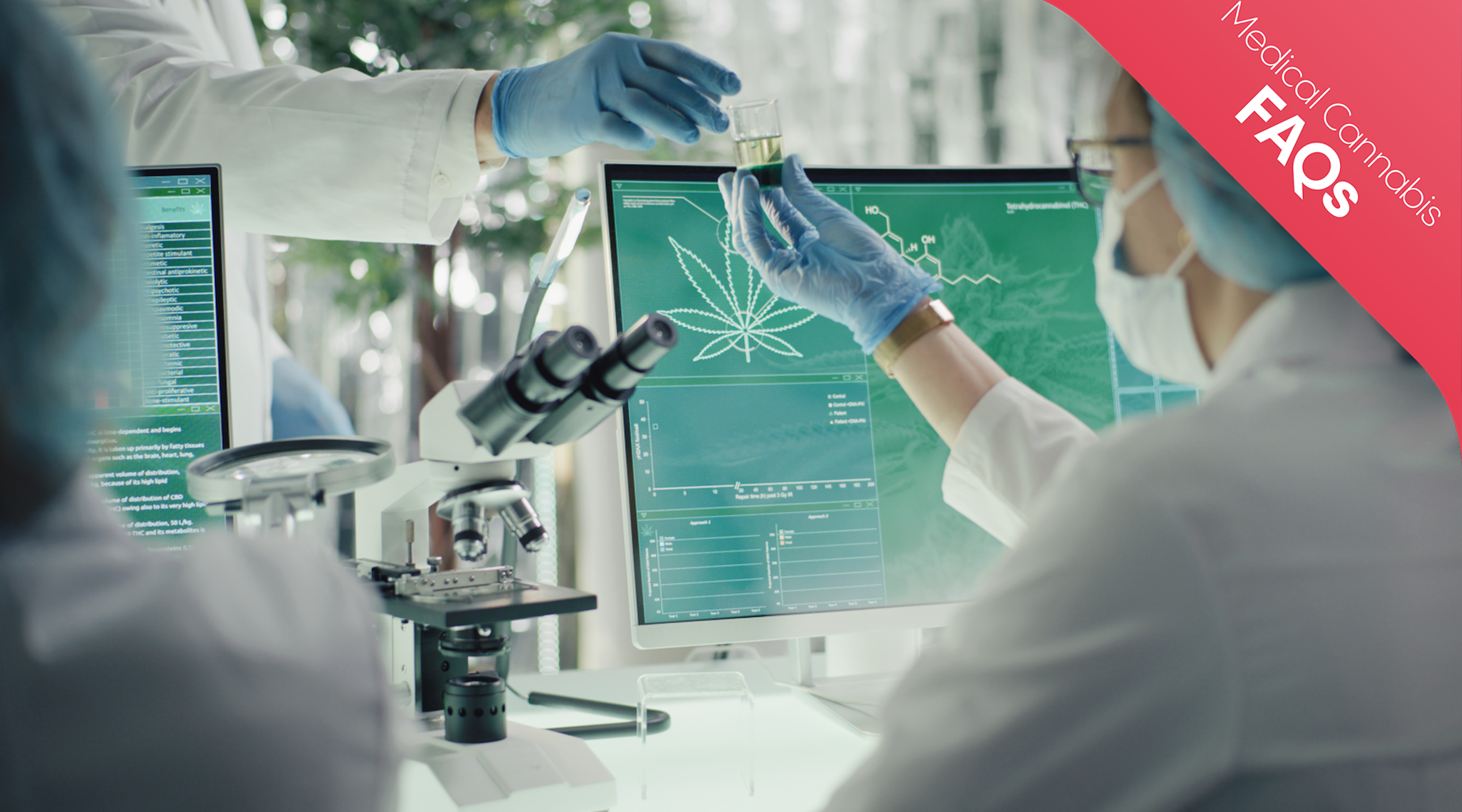Contents
Navigating the Basics of Cannabis Medicine
Unlike in many other areas of medicine, the ingredients and chemical compounds that make up cannabis-based treatments are discussed freely and openly by doctors and their patients, but often the basics are overlooked, and this can lead to confusion.
In order to navigate which of the many cannabis strains, oils, or products, that have been recommended by your doctor, may work best for you, it's important to have a basic understanding of cannabinoids.
So, as part of our frequently asked questions series, we’ve decided to strip back to the basics and explain what cannabinoids actually are, how cannabinoids affect the body, and how cannabinoids can be utilised for medicinal purposes.
What are cannabinoids?
Cannabinoids are a class of chemical compounds that bind to receptors in our bodies. These receptors are part of an incredibly complex and intricate system called the endocannabinoid system (ECS), which is responsible for maintaining homeostasis and keeping us healthy.
Our bodies naturally create a class of cannabinoids, called endocannabinoids, to interact with these receptors and regulate ECS responses, which can include cardiovascular, immune, and nervous system functions.
Cannabinoids in Nature and Medicine
Plants, like cannabis, also naturally produce cannabinoids - these are known as phytocannabinoids. The most famous, and heavily researched, cannabis cannabinoids are CBD (Cannabidiol) and THC (Tetrahydrocannabinol).
For millennia these phytocannabinoids, and many others, have been used in medicinal or therapeutic practices because they are able to interact with the same receptors as endocannabinoids, and boost or influence the responses and functions regulated by the ECS.
The Rise of Synthetic Cannabinoids
Through technological advancement over the last thirty years, there is now a third class of cannabinoids: synthetic cannabinoids. These compounds are man-made versions of cannabinoids and are manufactured in laboratories. Now, scientists are able to manipulate or modify different aspects of cannabinoid compounds to boost their overall effects upon consumption.
Some synthetic cannabinoids, like Nabilone and Dronabinol (which are synthetic versions of THC), are used in medicinal practices, but others enter the market with unknown risks due to a lack of regulations and standardised testing. So, it is important to exercise caution with synthetic cannabinoids.
What are the main cannabinoids found in cannabis?
Scientists believe that the cannabis plant contains around 540 different chemical compounds, over 100 of which are cannabinoids - or phytocannabinoids. The most well known, and abundantly available within cannabis, are Cannabidiol (CBD) and Tetrahydrocannabinol (THC).
Cannabidiol (CBD)
Cannabidiol is a non-psychoactive cannabinoid that is naturally produced by cannabis and hemp plants. Available to purchase over the counter in the UK, and in many other countries around the world, CBD is used by thousands every day as a health or lifestyle supplement in oil, tincture, topical, edible or capsule form.
In 2017, the World Health Organisation decided CBD should not be classed as a controlled substance, and there is no evidence to suggest CBD is unsafe. In fact, evidence shows cannabinol has shown potential in reducing anxiety and boosting mood, lowering inflammation, redness, swelling, improving sleep and pain, and dramatically reducing seizures in epileptic children.
Cannabigerol (CBG)
CBG is a non-psychoactive cannabinoid that is created by an acidic cannabinoid and monoterpene called cannabigerolic acid (CBGA). Throughout the cannabis plant's life cycle CBG converts into THC and CBD, and so it is considered a major cannabinoid.
CBG has shown particular promise in the management of neurological disorders like Parkinson’s disease, Huntington’s disease, multiple sclerosis and inflammatory bowel disease because of its anti-inflammatory and analgesic (pain relieving) qualities.
Cannabinol (CBN)
Cannabinol is another non-intoxicating major cannabinoid present in cannabis. When cannabis is exposed to air and light, THC can break down and convert into CBN and so, the two are extremely similar in chemical structure.
Researchers believe CBN could have medicinal and therapeutic effects that may benefit a plethora of health conditions due to its anti-inflammatory, analgesic, antibacterial and neuroprotective properties. Cannabinol has also shown to have sedative effects, and so may be useful in managing sleep concerns or anxiety and stress disorders.
Cannabichromene (CBC)
Like CBG, cannabichromene (CBC) is formed by an acidic cannabinoid, and chemical precursor called cannabichromenic acid (CBCA) once a cannabis plant is exposed to heat and ultraviolet light.
CBC is a non-psychoactive cannabinoid that, in comparison to THC and CBD, has not been researched thoroughly by scientists yet. However, the limited research that is available indicates CBC may have a positive influence on pain, swelling, and depression.
Tetrahydrocannabinol (THC)
Most famous, and often demonised, for its psychoactive properties and ability to induce a ‘high’, THC is one of the most powerful cannabis cannabinoids. Tetrahydrocannabinol can have incredibly therapeutic effects on certain patients, but can also be abused or misused if not properly managed.
Patient testimonials and research from around the world have indicated tetrahydrocannabinol has potential to help relieve and manage pain and nausea, as well as improving sleep problems and low appetites.
Tetrahydrocannabivarin (THCV)
As its name would suggest, THCV is very similar to THC in terms of molecular structure and psychoactive characteristics. However, unlike tetrahydrocannabinol, THCV typically has to be administered in high doses to have a psychoactive effect or a mood-uplifting effect on the consumer.
Tetrahydrocannabivarin (THCV) affects the nerve cells in the brain to reduce cravings and relieve anxiety, and so it may be a useful ingredient for those using medicinal cannabis to control their appetite, addiction, anxiety, or panic attacks.
What is the endocannabinoid system?
Although cannabis, and its cannabinoid contents, interacts with the endocannabinoid system, this is not its primary function. The endocannabinoid system is responsible for regulating a vast array of functions and responses, including those relating to mood, memory, pain sensation, inflammation, and appetite.
However, this incredibly important network of receptors and chemicals was not uncovered until research into medical cannabis advanced, which was stalled enormously over the years because of prohibition and stigmatisation, despite the plant's strong roots in ancient medicine.
Discovery of the first cannabinoid receptor: CB-1
Over twenty years after the successful isolation of THC in the 1960s, scientists at the Department of Pharmacology at St Louis University Medical School in Missouri discovered the first part of the endocannabinoid system: the cannabinoid receptor type 1 (CB-1) when they were analysing how rat’s brains were influenced by THC.
From here they discovered how densely populated the brain is with CB-1 receptors, and scientists then went on the hunt for more receptors, and for a natural chemical that was being created to interact with them.
Discovery of the first endocannabinoid: AEA
A few years later, the first endocannabinoid was discovered, and named anandamide (AEA). AEA was found to interact with CB-1 receptors and create the feeling of a ‘runner’s high’ after exercising and strengthened previous findings from animal studies that showed the CB-1 receptor influenced mood, amongst other things.
Discovery of the endocannabinoid system (ECS)
A short while later in 1993, a second type of cannabinoid receptor, aptly named CB-2, was also found. Unlike CB-1 receptors, CB-2 receptors were found all over the body, such as in white blood cells, in the spleen and in the immune system, and a second class of endocannabinoid was also discovered named 2-AG.
2-AG endocannabinoids were found to have binding ability with both types of receptors, meaning they can be sent to activate any cannabinoid receptor, in the brain, in tissue, in the immune system, or in the central nervous system; to reinstate, regulate, or rebalance any of the functions the ECS is responsible for.
Because of its wide array of influence, having a functioning endocannabinoid system is integral to our health and wellbeing. Sometimes our ECS’ can become overloaded and ineffective at managing a particular problem on its own, medication can be prescribed to assist in these areas - such as medical cannabis.
How do phytocannabinoids interact with the endocannabinoid system?
We now know that when consumed, cannabinoids that aren’t naturally produced by the body, such as phytocannabinoids and synthetic cannabinoids, act in a similar way to 2-AG and AEA.
Upon entering the body, different cannabinoids are able to disguise themselves as endocannabinoids and interact with CB-1 and CB-2 receptors across the endocannabinoid system, in turn affecting biological responses and function.
How does THC interact with the endocannabinoid system?
Like 2-AG, THC is known to be an agonist to both types of cannabinoid receptors and binds directly to them in the body, giving it the potential to affect or influence any of the functions regulated by the ECS.
THC boosts biological responses to rectify pain, or manage mood, inflammation, sleep, memory and motor control, or even assist in functions involved with digestion, metabolism, and appetite.
How does CBD interact with the endocannabinoid system?
CBD on the other hand, indirectly influences these receptors, and is not thought to bind directly to them. Instead, CBD ensues a kind of relay race within the body.
CBD binds to a type of receptor named TRPV1, which in turn boosts the bodies natural production of anandamide (AEA) so that it can bind to cannabinoid receptors, and reinstate balance or homeostasis within the endocannabinoid system naturally.
How do different cannabinoids interact with the endocannabinoid system?
CBC also interacts with TRPV1 receptors and TRPA1 receptors to influence natural endocannabinoid functions, but is also thought to stimulate CB-2 receptors to some degree.
THCV is able to influence both types of cannabinoid receptors, and depending on its concentration, can behave as an agonist (by binding to receptors) or as an antagonist (by stopping other molecules from binding) to CB-1 receptors.
Other research indicates other phytocannabinoids, like CBN and CBG, have high binding affinity to CB-1 and CB-2 receptors, and are also believed to act as partial agonists to these receptors, and so these cannabinoids can also influence ECS function.
What is The Entourage Effect?
When discussing how cannabinoids affect the body, it is important to mention the entourage effect. The Entourage Effect is a widely accepted theory in cannabis medicine that explains how cannabinoids work synergistically with each other.
It is thought that when cannabinoids like THC, THCV, CBD, CBC, and CBD are introduced into the body together, they have strength in numbers, and they work to enhance or modulate the effects of one another.
Just like an orchestra building up to a crescendo, during the entourage effect, cannabis cannabinoids, terpenes, and flavonoids all work together to have the most beneficial therapeutic effect on the body.
When whole plant medical cannabis, which contains the entire plant’s profile (including cannabinoids, terpenes, and flavonoids), is consumed, the cannabinoids it contains split up to target different receptors around the body to rectify as much as possible; from inflammation and swelling, to low mood and low appetite.
Conclusion
Hopefully, this offers more insight into the fundamental roles cannabinoids play in the efficacy of medicinal cannabis and cannabis-based treatments when addressing health concerns.
Understanding the dominant, or highly prominent, cannabinoids within various cannabis strains is crucial in tailoring your treatment to best suit your symptoms and lifestyle. The diverse effects of cannabinoids like CBD, THC, CBG, CBC, CBN and THCV on endocannabinoid systems, and their interactions with one another, makes for an abundance of options when configuring the best medicinal blend for you.
Once armed with this knowledge, newcomers can start to navigate their way through the different cannabinoid ratios available across various cannabis-based product ranges, and make well-informed decisions when it comes to their health.
Don't let the stigma surrounding medical cannabis prevent you from getting a suitable treatment. Releaf provides tailored monthly packages, specialist consultations for medical cannabis, and a unique medical cannabis card for protection, all based on your medical cannabis prescription.
Share article
Did you like this article?
It is important to seek medical advice before starting any new treatments. The patient advisors at Releaf are available to provide expert advice and support. Alternatively, click here to book a consultation with one of our specialist doctors.
Elevate your wellness with medical cannabis
Get comprehensive care, convenience, and confidence with an all-in-one treatment plan.
Am I eligible?Authors
With five years of journalism and healthcare content creation under her belt, Lucy strives to improve medical cannabis awareness and access in the UK by producing high quality, credible content.
fact checked
Compliance Director
Editorial Policy
All of our articles are written by medical cannabis experts, guided by strict sourcing guidelines, and reference peer-reviewed studies and credible academic research. Our expert clinical team and compliance specialists provide valuable insights to ensure accuracy when required. Learn more in our editorial policy.
Need more help?











